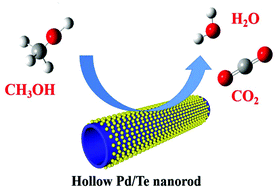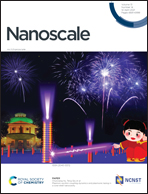Hollow Pd/Te nanorods for the effective electrooxidation of methanol†
Abstract
Methanol electrooxidation is significant in realizing effective C1 liquid fuel applications. Herein, hollow Pd/Te nanorods were fabricated and evaluated for methanol oxidation, and they were found to exhibit high catalytic efficiency for methanol oxidation in alkaline electrolyte compared to Pd or Pd/C catalysts. The hybrid structure of hexagonal crystal Te and face-centered cubic Pd was formed by microwave assisted Pd nanoparticle deposition over the surface of Te nanorods. Strong electronic effects and facile oxophilic properties were indicated in the Pd/Te system by spectroscopic analysis, which mainly accounts for the high catalytic performance for methanol oxidation. Specifically, they showed a peak current density of 90.1 mA cm−2 for methanol oxidation, around 3.5 times higher than that of commercial Pd/C (26.3 mA cm−2). High catalytic stability was also observed for Pd/Te, with a current retention of 64.3% after 3600 s of chronoamperometric testing, much higher than for Pd catalysts (20.1%). High anti-CO poisoning ability of the Pd/Te catalyst was demonstrated in the CO-stripping voltammetry results, and faster catalytic kinetics were also observed for this catalyst system. The electron-rich state of Pd and high active site exposure are responsible for the high performance of the Pd/Te catalyst in methanol oxidation.



 Please wait while we load your content...
Please wait while we load your content...